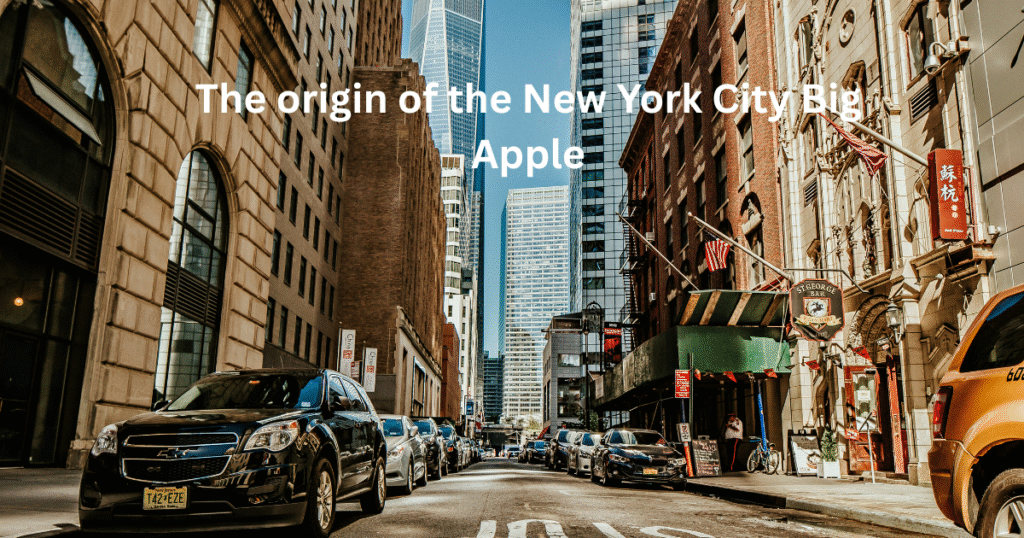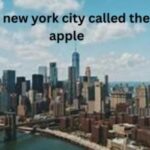Fascinated to know why New York City is the Big Apple? Explore the history of this legendary nickname, from horse racing to jazz to current-day fame. Discover the New York City Big Apple origin in this entertaining.
So, Why’s New York City Big Apple origin?
If you’ve ever strolled through the chaos of Times Square, munched on a bagel in Brooklyn, or just dreamed of New York City from afar, you’ve probably heard it called the “Big Apple.” It’s one of those nicknames that just feels right, like it was made for the city’s bright lights and big dreams. But where did it come from? The origin of New York City’s Big Apple is a tale of grit, jazz, and a dash of marketing brilliance. Pull up a chair—perhaps visualize yourself sitting at a classic NYC diner—and let’s get into the history of how New York acquired its legendary nickname.

Back in the Day: The Roots of the Big Apple
Imagine New York City in the 1920s—flapper gowns, smoky speakeasies, and the din of horse racing crowds. That’s where the origin of the New York City Big Apple begins. Then, “Big Apple” was not a city motto; it was an adjective for something big, great, or chase-worthy. And what better city to chase one’s dreams than New York?
The Horse Racing Roots
The earliest thread of the New York City Big Apple origin ties to horse racing, which was huge back then. New York’s racetracks—like Belmont Park or Aqueduct—were where the best horses, jockeys, and dreamers showed up. Winning a race in New York? That was the ultimate score, the “Big Apple” of prizes.
A sportswriter named John J. Fitz Gerald is the guy who really got this nickname rolling. On February 18, 1924, he wrote a column in the New York Morning Telegraph called “Around the Big Apple.” He shared how folks in the racing world—stable hands, jockeys, you name it—called New York’s tracks the “Big Apple” because they were the place to be. It was like saying, “If you make it here, you’ve made it.” Fitz Gerald’s words hit home, and the New York City Big Apple origin started spreading like wildfire.
Jazz, Harlem, and a Whole Lotta Swagger
Horse racing gave the nickname a spark, but the New York City Big Apple origin caught fire in the jazz clubs of the 1920s and 1930s. If you know anything about the Harlem Renaissance, you know New York was the place for music, art, and culture back then. Harlem’s streets were alive with the sounds of trumpets and the clink of glasses in places like the Cotton Club.
The Big Apple Dance That Took Over
By the 1930s, “Big Apple” wasn’t just a phrase—it was a movement. A dance called the Big Apple popped up in African American communities, a high-energy, circle dance that had everyone laughing and swinging. It was named after New York City, a nod to the city’s rep as the coolest spot around. People danced the Big Apple from South Carolina to Chicago, and every step helped cement the New York City Big Apple origin in the national imagination.
Jazz Cats and Their Love for NYC
Jazz musicians were head over heels for New York, and they spread the Big Apple love. For them, playing a gig in Harlem or Midtown was like hitting the lottery. Legends like Duke Ellington and Ella Fitzgerald tossed around “Big Apple” to describe New York as the place where dreams came true. Their music and slang gave the New York City Big Apple origin a soulful, rhythmic heartbeat.
The 1970s Glow-Up: Bringing the Big Apple Back
Fast forward to the 1960s and 1970s, and New York City was going through a rough patch. The streets were tougher, the vibe was heavier, and the “Big Apple” nickname was gathering dust. But the New York City Big Apple origin wasn’t done yet—it just needed a comeback.
A Marketing Move That Changed Everything
In 1971, a guy named Charles Gillett, who ran the New York Convention and Visitors Bureau, had a bright idea. New York needed to remind the world why it was awesome, and what better way than dusting off the “Big Apple” nickname? Gillett’s team launched a tourism campaign that was all about apples—red, shiny apples on posters, buttons, and ads that screamed, “Come to the Big Apple!” It was like giving the city a big, warm hug.
The campaign was a total home run. Tourists started pouring in, snapping photos and buying Big Apple souvenirs. New Yorkers, too, fell back in love with the nickname, wearing it like a badge of pride. That 1970s revival made the New York City Big Apple origin a permanent part of the city’s story.
You can see this
- medical-travel-insurance
- best-honeymoon-places-in-the-usa
Why the Big Apple Just Fits New York
The New York City Big Apple origin isn’t just about where the name came from—it’s about why it feels so perfect. The “Big Apple” captures New York’s hustle, heart, and larger-than-life spirit.
A Place for Big Dreams
New York’s always been where people go to chase something bigger—maybe a Broadway spotlight, a Wall Street deal, or just a new start. The “Big Apple” is like that one perfect apple on the tree, the one you stretch to grab. That’s the New York City Big Apple origin: a nickname that says, “This is where you make it happen.”
A Nickname That Travels the World
Ask someone in Paris or Mumbai about the Big Apple, and they’ll know it’s New York. It’s in movies, songs, and that selfie you took with the Empire State Building. The New York City Big Apple origin has gone global, and it’s not slowing down.
Knitting New York Together
New York’s a city of neighborhoods, from the bodegas of the Bronx to the brownstones of Brooklyn. The “Big Apple” gives everyone a piece of the same story, something to rally around.
Clearing Up Some Big Apple Myths
Every good story comes with a few tall tales, and the New York City Big Apple origin is no exception. Let’s set the record straight on a couple of myths.
Myth 1: It’s About Apple Orchards
Some people think the Big Apple is about New York’s apple farms. I mean, upstate’s got some great orchards, but the nickname’s not about fruit. The New York City Big Apple origin comes from slang, not cider.
Myth 2: It Goes Way Back to the 1800s
You might hear the term started in the 19th century, but that’s not true. The New York City Big Apple origin kicked off in the 1920s with Fitz Gerald’s column—before that, it wasn’t a thing.
Myth 3: It’s Just a Marketing Stunt
The 1970s campaign gave the nickname a boost, but it wasn’t cooked up in an ad agency. The New York City Big Apple origin has real roots in racing and jazz, way before the posters went up.
The Big Apple Now: Still the Star of the Show
Walk around New York City today, and the Big Apple is everywhere. From “I Love NY” shirts with apple logos to street art in Queens, the New York City Big Apple origin is alive and well.
The Big Apple in Movies and Music
Ever seen When Harry Met Sally and swooned over those New York scenes? Or blasted Jay-Z and Alicia Keys’ “Empire State of Mind”? The Big Apple is a pop culture icon, popping up in everything from rom-coms to rap anthems. The New York City Big Apple origin keeps inspiring artists to capture the city’s magic.
New Yorkers Keeping It Real
Locals love their nickname. There’s the Big Apple Circus, a kid-friendly show that’s been a New York staple since 1977. You’ll also find Big Apple bakeries, coffee shops, and even gyms. It’s a nickname that feels like family.
How the Big Apple Compares to Other Nicknames
Just for kicks, let’s see how the New York City Big Apple origin stacks up against other city nicknames:
- Chicago: The Windy City – Maybe it’s the lake breeze or the city’s big talkers, but it’s got charm.
- Los Angeles: City of Angels – Sounds dreamy, tied to its Spanish roots, but it’s less gritty than the Big Apple.
- New Orleans: The Big Easy – Chill and musical, it’s like the Big Apple’s laid-back cousin.
The New York City Big Apple origin wins for its mix of history, heart, and that unmistakable New York attitude.
Wrapping It Up: Here’s to the Big Apple!
The New York City Big Apple origin is like a love song to the city. From racetracks to jazz dives to a 1970s marketing miracle, this nickname has seen New York through it all. It’s more than a name—it’s a feeling that says, “This is where the magic happens.” Whether you’re dodging taxis in Manhattan or sipping coffee in Williamsburg, you’re part of the Big Apple’s story.
So, next time someone asks, “Why’s New York the Big Apple?” you’ve got the whole scoop. The New York City Big Apple origin reminds us why this city’s always been the biggest, boldest apple on the tree. Here’s to New York—keep sparkling, Big Apple!
FAQs About the New York City Big Apple Origin
1. When did New York become the Big Apple?
It started in 1924, thanks to a sportswriter named John J. Fitz Gerald in the New York Morning Telegraph.
2. Is the Big Apple about actual apples?
Nope, it’s slang from horse racing and jazz, not fruit. The New York City Big Apple origin is all about chasing the big prize.
3. Why did the 1970s campaign use the Big Apple?
It was a way to make New York feel fun and inviting during some tough years.
4. Do people still call New York the Big Apple?
Totally! It’s on everything from souvenirs to social media, keeping the New York City Big Apple origin alive.
- When did New York get the Big Apple nickname?
It began in 1924, due to John J. Fitz Gerald’s column in the New York Morning Telegraph. - Is the Big Apple really about real apples?
Nah, it’s horse racing and jazz slang, not fruit. The origin of the New York City Big Apple is all about pursuing the big prize. - Why did the 1970s campaign choose the Big Apple?
It was how to make New York feel fun and hospitable again in difficult times. - Is anyone still using the Big Apple nickname?
You bet! It’s on everything from T-shirts to TikToks, keeping the New York City Big Apple origin alive.









